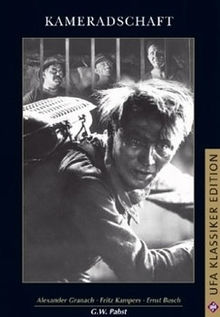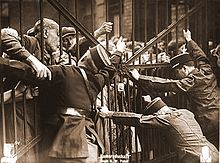- Kameradschaft
-
Kameradschaft 
German DVD CoverDirected by Georg Wilhelm Pabst Produced by Seymour Nebenzal Written by Peter Martin Lampel
Karl Otten
Ladislaus VajdaStarring Ernst Busch Cinematography Robert Baberske
Fritz Arno WagnerEditing by Jean Oser
Marc SorkinDistributed by Janus Films Release date(s) Germany:
November 17, 1931
United States:
November 8, 1932Running time 93 minutes (Germany)
86 minutes (Janus)Country Germany
FranceLanguage German
FrenchComradeship (German: Kameradschaft) (1931) is a dramatic film with socialist overtones directed by German director Georg Wilhelm Pabst. The French-German co-production drama is noted for combining expressionism and realism (predating the Italian neo-realist films).[1]
The picture tells of a mine disaster where German miners rescue French miners from an undergound fire and explosion. The story takes place in the Lorraine/Saar region, along the border between France and Germany.
Contents
Plot
After the end of World War I, due to the Treaty of Versailles, an old German mine is split in two because of the new border, and the mine is closed off at the border, including an underground mine. The economic downturn and employment situation adds to tension between the two countries as German workers seek employment with the French but are turned away.
In the French part of the mine a fire breaks out and they try to contain the fire by building brick walls. The Germans continue to work on their side.
Nonetheless the fire gets out of control, causing an explosion that traps many French miners. In response, Wittkopp (Ernst Busch) appeals to his bosses to send a rescue team. As they ride out of town to help, the leader of the German rescue effort explains to his wife that the French are men with women and children and he would hope that they would come to his aid in similar circumstances.
Meanwhile, a trio of German miners breaks through a set of steel bars that mark the 1919 border. On the French side, an old retired miner (Alex Bernard) sneaks into the shaft hoping to rescue his young grandson (Pierre-Louis).
The miners forget their nationalities and past troubles and try to build a new camaraderie on the foundation of human solidarity.
The Germans successfully rescue the French miners, not without some interesting difficulties. After all the survivors are rescued, there's a big party with speeches about friendship between the French and Germans. The film shows a new idealistic unity between the miners, despite the political and nationalistic obstacles that still remain.
At the end, ironically, French officials rebuild the mining gate, and return to the status quo ante.
Cast
- Alexander Granach as Kasper
- Fritz Kampers as Wilderer
- Ernst Busch as Wittkopp
- Elisabeth Wendt as Frau Wittkopp
- Gustav Puttjer as Kaplan
- Oskar Hocker as Obersteiger
- Daniel Mendaille as Jean Leclerc
- Georges Charlia as Emile
- Andree Ducret as Francoise
- Alex Bernard as Grand-Pere, Le Vieux Mineur
- Pierre-Louis as Georges - Le Petit Galibot
- Helena Manson as Rose, La Femme Du Mineur Blesse
- Gerhard Bienert
- Marguerite Debois
- Adolf Fischer
- Friedrich Gnass
- Georg Guertler
- Willem Holsboer as Ingenieur Des Deutschen Bergwerks
- Marcel Lesieur as Albert
- Palmyre Levasseur
- Marcel Merminod
- Teddy Michaud
- Naupel
- Reinhardt
- Rortais
- Franz Schier
- Theo Tony
- Georges Tourreil as L'Ingenieur
- Richard Weichert
- Fritz Wendhausen as Direktor Des Deutschen Bergwerks
Background
Main article: Courrières mine disasterPabst took an actual historical event, a mining accident in 1906 in Courrières, France, where rescue efforts were hampered by the lack of trained mine rescuers. Expert teams from Paris and Germany (miners from the Westphalia region) came to the assistance of the French miners. There were 1,099 fatalities, including children.[2]
Title
Kameradschaft in German means a bond between soldiers or those who have similar opinions and are in friendship. The word is similar to comradeship.
Critical reception
Film critic Daniel Curran calls the film "A heartfelt plea for peace and internationalism." While calling the narrative over-sentimental, Curran appreciated the film, writing, "Pabst's plea for a peaceful future is both noble and honest, his direction of the heartbreak and devastation [is] enhanced by the brilliant cinematography by Fritz Arno Wagner and Robert Baberske, and the frighteningly real set design by Erno Metzner and Karl Vollbrecht."[3]
When the film was released in the United States in 1932, Mordaunt Hall, film critic for The New York Times, reviewed the film and liked the realism and the screenplay, writing, "[Kameradschaft is] one of the finest examples of realism that has come to the screen...[the] scenes in the mine are so real that one never thinks of them as being staged...[and] [t]hroughout the length of this tale of horror one feels as though one were permitted through some uncanny force to look into all parts of the mine...[and] all the noises and sounds are wonderfully natural."[4]
The staff at Variety magazine also gave the film a positive review. They appreciated the direction, story, and cinematography, writing, "Pabst has made it a powerful recounting and accentuates more the happenings than the men...Photography and architecture are excellent and the sound is clear. Picture sometimes abrupt and there are some superfluous scenes but this is an outstanding film."[5]
Awards
Wins
- National Board of Review: Top Foreign Films; 1932.[6]
See also
References
- ^ Kameradschaft at the Internet Movie Database.
- ^ Steffen, James. Turner Movie Classics, review and analysis, 2007. Last accessed: December 11, 2007.
- ^ Curran, Daniel, ed. Foreign Films, film review and analysis, page 85, 1989. Evanston, Illinois: Cinebooks. ISBN 0-933997-22-1.
- ^ Hall, Mourdaunt. The New York Times, film review, November 9, 1932. Last accessed: December 11, 2007.
- ^ Variety. Staff film review, 1931. Last accessed: December 11, 2007.
- ^ National Board of Review awards database and web site. Last accessed: December 12, 2007.
External links
- Kameradschaft at the Internet Movie Database
- Kameradschaft at the TCM Movie Database
- Kameradschaft at Film Reference
- Kameradschaft at Cinegraph (German)
Films directed by G. W. Pabst 1920s The Treasure · Gräfin Donelli · Joyless Street · Secrets of a Soul · One Does Not Play with Love · The Love of Jeanne Ney · The Devious Path · Pandora's Box · Diary of a Lost Girl · The White Hell of Pitz Palu1930s Westfront 1918 · Skandal um Eva · The Threepenny Opera · Kameradschaft · L'Atlantide · Adventures of Don Quixote · High and Low · That Night · A Modern Hero · Street of Shadows · The Shanghai Drama · Girls in Distress1940s 1950s Voice of Silence · Cose da pazzi · The Confession of Ina Kahr · The Last Ten Days · Jackboot Mutiny · Ballerina · Through the Forests and Through the TreesCinema of Germany 
Film chronology · German Empire 1895–1918 · Weimar Germany 1919–1933 · Nazi Germany 1933–1945 · East Germany (1945–1990) ·
(West) Germany 1945–present · 1945-1959 · 1960s · 1970s · 1980s · 1990s · 2000s · 2010s
Actors · Directors · Films A–Z · Cinematographers · Festivals · Producers · Composers · ScreenwritersCategories:- 1931 films
- 1930s drama films
- Black-and-white films
- Films directed by Georg Wilhelm Pabst
- Films of Weimar Germany
- French films
- French-language films
- German films
- German-language films
Wikimedia Foundation. 2010.

